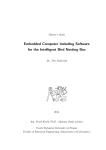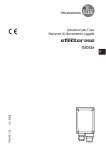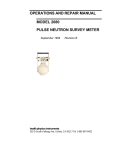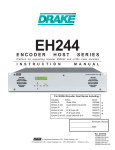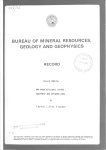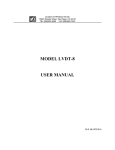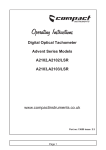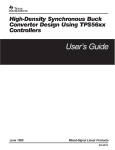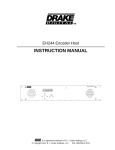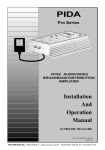Download Evaluate: MAX3514/MAX3516/MAX3517 MAX3514
Transcript
19-1826; Rev 0; 3/01 MAX3514/MAX3516/MAX3517 Evaluation Kits Access to the device input and output is provided through 50Ω SMA connectors. The input is matched to 50Ω, while the output circuit includes a minimum-loss pad that presents a 75Ω load to the output transformer when using 50Ω test equipment. Windows is a registered trademark of Microsoft Corp. Features ♦ +5V Single-Supply Operation ♦ Output Level Range up to 64dBmV (QPSK) ♦ Gain Programmable in 0.5dB Steps ♦ Transmit-Disable Mode ♦ Shutdown Mode ♦ Control Software Included ♦ Fully Assembled and Tested Surface-Mount Board Ordering Information PART TEMP RANGE IC PACKAGE MAX3514EVKIT -40°C to +85°C 20 QSOP MAX3516EVKIT -40°C to +85°C 20 TSSOP-EP* MAX3517EVKIT -40°C to +85°C 20 QSOP * Exposed paddle. Component List—MAX3514 DESIGNATION QTY C1, C6 2 C2, C5, C8, C9, C11 5 DESCRIPTION QTY T2 1 Transformer 2 to 1 voltage ratio, type B5F Toko 348PT-1087 U1 1 MAX3514EEP 20-pin QSOP J1 1 SMA connector (PC mount) Johnson 142-0701-201 or Digi-Key J502-ND J2 1 DB25 connector, right angle – female Digi-Key A2102-ND or AMP 745783-4 JU1–JU7 7 1 ✕ 3 pin headers (0.1in centers) Digi-Key S1012-36-ND Leave site open 0.1µF ±10% ceramic capacitors (0603) Murata GRM39X7R104K016A C3, C4 2 1000pF ±10% ceramic capacitors (0603) Murata GRM39X7R102K050A C7 1 10µF ±10%, 16V min tantalum capacitor AVX TAJC106K016 R1 1 49.9Ω ±1% resistor (0603) R2, R3, R4, R6–R13, R16–R19 15 Leave site open R5 1 43.2Ω ±1% resistor (0805) R14, R15 2 100kΩ ±5% resistors (0603) R21 1 86.6Ω ±1% resistor (0805) L1 1 0Ω resistor (0805) B3–B6 4 Murata BLM21A601RPT 1 Transformer 1 to 1 Macom ECT1-1T T1 DESIGNATION DESCRIPTION JU1–JU7 7 Shunts, Digi-Key S9000-ND IN1, IN2 2 Test points, Digi-Key 5000K-ND None 1 MAX3514/MAX3517 EV kit circuit board, Rev. 2 None 1 MAX3514/MAX3516/MAX3517 software disk None 1 MAX3514/MAX3516/MAX3517 data sheet None 1 MAX3514/MAX3516/MAX3517 EV kit data sheet ________________________________________________________________ Maxim Integrated Products For pricing, delivery, and ordering information, please contact Maxim/Dallas Direct! at 1-888-629-4642, or visit Maxim’s website at www.maxim-ic.com. 1 Evaluate: MAX3514/MAX3516/MAX3517 General Description The MAX3514/MAX3516/MAX3517 evaluation kits (EV kits) simplify evaluation of the MAX3514/MAX3516/ MAX3517 CATV upstream amplifiers. Each kit includes a data interface that can be programmed through the parallel port of a standard PC. Software (Windows® 95/98 compatible) is included to facilitate this function. This software allows the user to program both the gain and transmit modes through a simple user interface. Evaluate: MAX3514/MAX3516/MAX3517 MAX3514/MAX3516/MAX3517 Evaluation Kits Component List—MAX3516 DESIGNATION QTY C1, C4, C6, C8, C9 5 C2, C3 2 C5, C10 2 C7 1 R1 R2, R3, R4, R6–R13, R16–R19, R22, R23 R5 R14, R15 R21 B1, B2 1 B3–B6 1 2 1 2 4 T1 1 T2 1 U1 1 J2 1 J1, J3 JU1–JU7 2 17 2 7 JU1–JU7 7 IN1, IN2 2 None None None None 1 1 1 1 DESCRIPTION 0.1µF ±10% ceramic capacitors (0805) Murata GRM40X7R104K016A 1000pF ±10% ceramic capacitors (0805) Murata GRM40102K050A Open 10µF tantalum capacitor ±10%, 16V min AVX TAJC106K016 49.9 Ω ±1% resistor (0402) Open 43.2Ω ±1% resistor (0805) 100kΩ ±5% resistors (0805) 86.6Ω ± 1% resistor (0805) 0Ω resistors (0805) BLM21A601RPT Murata 1-to-1 transformer Macom ETC1-1T 4-to-1 transformer type B5F TOKO 458PT-1087 MAX3516EUP, 20-pin TSSOP-EP DB25 connector, right angle, female Digi-Key A2102-ND SMA connectors (edge mount) EFJohnson 142-0701-801 Digi-Key J502-ND Note: Cut center pin to approximately 1/16in length. 1 x 3 pin headers (0.1in centers) Digi-Key S1012-36-ND Shunts Digi-Key S9000-ND Test points Digi-Key 5000K-ND MAX3516 EV kit circuit board, Rev A MAX3514 software disk MAX3516 data sheet MAX3516 EV kit data sheet Component List—MAX3517 DESIGNATION QTY C1, C6 DESCRIPTION 2 Leave site open C2, C5, C8, C9, C11 5 0.1µF ±10% ceramic caps (0603) Murata GRM39X7R104K016A C3, C4 2 1000pF ±10% ceramic caps (0603) Murata GRM39X7R102K050A C7 1 10µF ±10%, 16V min tantalum cap AVX TAJC106K016 R1 1 49.9Ω ±1% resistor (0603) R2, R3, R4, R6–R13, R18, R19 13 Leave site open R5 1 43.2Ω ±1% resistor (0805) R14, R15 2 100kΩ ±5% resistors (0603) R16, R17 2 300Ω ±5% resistors (0603) R21 1 86.6Ω ±1% resistor (0805) L1 1 0Ω resistor (0805) B3–B6 4 Murata BLM21A601RPT T1 1 Transformer 1 to 1 Macom ECT1-1T T2 1 Transformer 2 to 1 voltage ratio, type B5F, Toko 348PT-1087 U1 1 MAX3517EEP 20-pin QSOP J1, J3 2 SMA connectors (PC mount) Johnson 142-0701-201 or Digi-Key J502-ND J2 1 DB25 connector, right angle – female, Digi-Key A2102-ND or AMP 745783-4 JU1–JU7 7 1 ✕ 3 pin headers (0.1in centers) Digi-Key S1012-36-ND JU1–JU7 7 Shunts, Digi-Key S9000-ND IN1, IN2 2 Test points, Digi-Key 5000K-ND None 1 MAX3514/MAX3517 EV kit circuit board, Rev. 2 None 1 MAX3514/MAX3516/MAX3517 software disk None 1 MAX3514/MAX3516/MAX3517 data sheet None 1 MAX3514/MAX3516/MAX3517 EV kit data sheet _______________________________________________________________________________________ MAX3514/MAX3516/MAX3517 Evaluation Kits JUMPER FUNCTION JU1 Set the method of control of SHDN JU2 Set the manual control state of SHDN JU3 Set the method of control of TXEN JU4 Set the manual control state of TXEN JU5 JU6 JU7 SHORT PIN1 TO PIN2 SHORT PIN2 TO PIN3 PC port control Manual control through JU2 Logic 1 state (VCC) Logic 0 state (GND) PC port control Manual control through JU4 Logic 1 state (VCC) Logic 0 state (GND) CS input PC port control N/A SDA input PC port control N/A SCLK input PC port control N/A Quick Start The MAX3514/MAX3516/MAX3517 EV kits are fully assembled and factory tested. Follow the instructions in the Connections and Setup section. Note: The output circuit includes a minimum-loss pad that is used to bring the load impedance up to 75Ω. This must be accounted for in all measurements (see Output Circuit section). Note: The input transformer is supplied to allow differential input drive from a single-ended source. A transformer is not required in the application. Test Equipment Required • DC supply capable of delivering 5.5V and 200mA of continuous current • HP 8648 or equivalent signal source capable of generating 40dBmV up to 200MHz • HP 8561E or equivalent spectrum analyzer with a minimum 200MHz frequency range • Digital multimeter (DMM) to monitor VCC and ICC, if desired • Lowpass filters to attenuate harmonic output of signal sources, if harmonic measurements are desired • Network analyzer, such as the HP 8753D (may be used to measure gain and harmonic levels if configured with this option; contact test equipment manufacturer) Table 2. MAX3514/MAX3616/MAX3517 EV Kit Software FILENAME DESCRIPTION Max3514.txt “Read Me” text file Max3514.exe Windows executable Max3510.dll DLL file for printer port control Msvbvm50.dll DLL file pins labeled +5V and GND on the circuit board. Connect a 50Ω signal source to INPUT (preset the signal source for -13dBm (+34dBmV across a 50Ω load)), and terminate OUTPUT with a spectrum analyzer or network analyzer having a 50Ω input impedance. If using a signal source with a source impedance other than 50Ω, or if a different input impedance is required, be sure to replace resistor R1 with the appropriate value resistor. 2) Connect a 25-pin male-to-male cable between the parallel (printer) port of the PC and the 25-pin female connector on the EV kit board. 3) See Table 1 for board jumper settings. 4) Turn on the power supply. Turn on the PC and the test equipment. 5) Run the software program. Detailed Description • IBM PC or compatible with Windows 95/98 installed Using the Software • Male-to-male 25-pin parallel cable, straight through The MAX3514/MAX3516/MAX3517 use a serial data interface (SDI) to set gain. Some means of communicating with the SDI is required to use the MAX3514/ MAX3516/MAX3517 EV kits. A microprocessor, pattern generator, or PC can be used for this function. Software is included in these EV kits to facilitate the use of a PC. • 0 to 5V pulse generator (transient measurement) • Low-noise amplifier with 40dB gain from 5MHz to 100MHz (noise measurement) • Oscilloscope with 200MHz bandwidth Connections and Setup 1) Connect the power supply (preset to +5V) to the _______________________________________________________________________________________ 3 Evaluate: MAX3514/MAX3516/MAX3517 Table 1. Jumper Setting Functions Evaluate: MAX3514/MAX3516/MAX3517 MAX3514/MAX3516/MAX3517 Evaluation Kits The disks included with the MAX3514/MAX3516/ MAX3517 EV kits contain four files each. Table 2 lists these files and their appropriate usage. If your PC has Windows 95/98 installed, run MAX3514.EXE. The software can also be found on the Maxim website. Gain Adjustment The valid gain code ranges from 0 to 127 (decimal). The nominal change in gain is 0.5dB per gain code. Gain codes are set exclusively by programming the SDI. Refer to the MAX3514/MAX3516/MAX3517 data sheet for details. High Power and Low Noise High-power (HP) mode and low-noise (LN) mode may only be controlled via the PC interface. Manual control of the jumpers for the EV kits’ boards is not possible. For DOCSIS applications, HP mode should be used for output levels above 42dBmV. This corresponds to gain code 87. LN mode should be used below this output level. This corresponds to gain code 115. A transition from HP mode, gain code 87, to LN mode, gain code 117, will result in a -1dB step. Shutdown and Transmit Enable Jumpers JU1 through JU4 determine how the shutdown and transmit-enable features are controlled. Pin 2 of JU2 and pin 2 of JU4 are connected directly to the device. If an external source (such as a modulator chip or microprocessor) is used to control these features, make the connections to pin 2 of JU2 and pin 2 of JU4. Pads are provided on the board (R18 and R19, respectively) for placement of termination resistors, if needed. If manual control of shutdown and transmit enable is desired, shunt pins 2 and 3 of jumper JU1 and pins 2 and 3 of jumper JU3. This will allow SHDN and TXEN to be controlled by JU2 and JU4, respectively. JU2 and JU4 are used to place either VCC or ground at SHDN or TXEN. Pin 3 of JU2 and pin 3 of JU4 are ground, and pin 1 is VCC. To control the SHDN and TXEN features using the software, shunt pin 1 and pin 2 of JU1 and JU3. Manual Control of Serial Data Interface If using a source other than a PC to drive the serial data interface of the MAX3514/MAX3516/MAX3517 EV kits (such as a digital pattern generator or microprocessor), remove the shunts on jumpers JU5, JU6, and JU7. Access to the serial data interface is available through these jumpers. Termination pads are provided (R2, R3, R4). Solder an appropriate resistor to these pads, if desired. Refer to the MAX3514/MAX3516/MAX3517 data sheet for a description of the serial data interface. 4 To control the SDI using the software, shunt pin 1 and pin 2 of JU5, JU6, and JU7. Input Circuit The input circuits of the MAX3514/MAX3516/MAX3517 EV kits are configured with a 1:1 transformer (T1) and a 49.9Ω input resistor. This allows the input to be driven with single-ended 50Ω test equipment. The transformer (T1) is used to generate a differential signal, as rated performance is specified with a differential input drive (typically from a differential lowpass filter). If the MAX3514/MAX3516/MAX3517 are to be driven single ended, the input transformer (T1) must be removed and the undriven input connected to ground through a 0.1µF blocking capacitor. Output Circuit The MAX3514/MAX3516/MAX3517 have differential outputs. This architecture aids in suppressing secondorder distortion (harmonics). To convert to a singleended output, a 2:1 voltage ratio transformer (T2) is used. Since most test equipment is supplied with a 50Ω termination impedance, a minimum-loss pad is provided on the output of the transformer to increase the load impedance to a nominal 75Ω. This places the proper load on the device, but will also reduce the measured output voltage level by 7.5dB. It is essential to consider this when making any measurements with the EV kit; 7.5dB must be added to all measurements of voltage gain and output voltage level (including noise) to arrive at the correct value for a 75Ω system. Use 75Ω test equipment, if available, and take the following steps: 1) Remove the 50Ω output SMA connector and replace it with a 75Ω connector. 2) Remove R5 and replace it with a 0Ω resistor or some other type of shunt. 3) Remove R21. 4) Be sure to use a 75Ω cable. Analysis Harmonic Distortion A filter will be needed to reject the harmonics generated by the signal source. For this example, a lowpass filter with approximately a 25MHz to 35MHz cutoff frequency will be required. This filter will need to reject at least 20dB of signal at 40MHz. Set the 50Ω signal source for 20MHz and -13dBm. Adjust the amplitude to account for the insertion loss in the filter. Verify with the spectrum analyzer that the second and third harmonics generated by the source are suppressed by at least 70dBc. _______________________________________________________________________________________ MAX3514/MAX3516/MAX3517 Evaluation Kits Connect a spectrum analyzer to OUTPUT. Set the center frequency for 40MHz and the span for 50MHz or more. Adjust the reference level so that the fundamental (20MHz tone) is within 10dB to 20dB of the reference level. If the fundamental is less than 10dB below the reference level, the harmonic distortion of the spectrum analyzer may prevent accurate measurement of the distortion. Set the gain code to 125, D7 = 1 (approximately 27dB of gain). Measure the level of the fundamental, second, and third harmonics on the spectrum analyzer. These readings have units of dBm. To convert from dBm to dBmV in a 50Ω system, use the following equation: X (dBmV) = Y(dBm) + 47dB (50Ω system) Add 7.5dB to this value to account for the attenuation of the minimum-loss pad, in dBmV, for a 75Ω load. The gain can now be calculated in dB, and the harmonic distortion can be calculated in dBc. Switching Transients To measure the transmit-enable and transmit-disable transients, the TXEN pin will be driven from an external source. No input signal is applied, and the output is viewed on an oscilloscope. Connect OUTPUT to the oscilloscope’s 50Ω input. Set the scope’s time base to 5µs/div and the vertical scale to 5mV/div. Set the pulse generator as follows: • Amplitude: 5V • Duty cycle: 50% • Rise/fall-time: 100ns • Pulse width: 25µs • Offset: 2.5V Output Noise To measure output noise, a spectrum analyzer is used. A postamplifier with less than 10dB noise figure and greater than 40dB gain within the band of interest is needed. With the power supply off, place a 50Ω termination on the input of the EV kit. Turn on the powers supply to the MAX3514/MAX3516/ MAX3517 EV kits. Using the software, set the device to transmit mode with a gain code of 119, D7 = 1 (approximately 24dB of gain, MAX3514). Connect the output of the postamplifier to the spectrum analyzer and the input to OUTPUT on the EV kit. Set the spectrum analyzer as follows: • Center frequency: 35MHz • Span: 60MHz • Reference: -50dBm • Scale: 10dB/div • IF bandwidth: 1kHz Power up the postamplifier. If the spectrum analyzer being used has a noise marker function, enable it. The output noise can now be read directly from the spectrum analyzer. Move this marker to 42MHz. Read the value of the noise density from the spectrum analyzer. This noise value is a combination of the output noise of the MAX3514/MAX3516/MAX3517, the gain of the postamplifier, and the noise figure of the postamplifier. With the specified noise figure of 10dB, the noise contribution of the postamplifier may be ignored. The minimum-loss pad reduces the actual measured value by 7.5dB. Use the following equation to arrive at the MAX3514/MAX3516/MAX3517s’ output noise in a 160kHz bandwidth: VNOISE = PNOISE + 47dB + 7.5dB + 10 ✕ log (160,000) - GAMP where: Take care not to drive the MAX3514/MAX3516/ MAX3517 TXEN pin below 0 or above +5V. Turn on the power supply. Remove the shunt from jumper JU3 (TXEN), and connect the output of the pulse generator to pin 2 of this jumper. Trigger the oscilloscope from the pulse generator using a convenient method. Set the gain code to 125, D7 = 1. A rising- and falling-edge transient should appear on the scope’s CRT. The amplitude of this transient should be less than 40mVp-p. Multiply the value of the measured transient by 2.37 to account for the presence of the minimum-loss pad. The gain may now be changed to show the output transient’s dependence on gain. VNOISE = MAX3514/MAX3516/MAX3517 output noise in dBmV measured in a 160kHz bandwidth PNOISE = Noise density in dBm/Hz read from the spectrum analyzer GAMP = Gain of the postamplifier in dB If the spectrum analyzer being used does not have a noise marker function, corrections must be made to account for the IF bandwidth used to make the measurement. Consult the user’s manual for your spectrum analyzer for details. Once the correction is made, the value read from the spectrum analyzer can be converted to a noise density (dBm/Hz), and the above formula can be used. _______________________________________________________________________________________ 5 Evaluate: MAX3514/MAX3516/MAX3517 Connect the filter between INPUT of the EV kit and the output of the signal source, making sure the proper terminations are being used for this particular filter. Evaluate: MAX3514/MAX3516/MAX3517 MAX3514/MAX3516/MAX3517 Evaluation Kits Noise can now be measured at various gains. Output noise in transmit-disable mode is insignificant. Component Suppliers SUPPLIER AVX M/A-COM Murata TOKO Layout Considerations The MAX3514/MAX3516/MAX3517 evaluation board can serve as a guide for your board layout. Particular attention should be paid to thermal design and to the output network. The MAX3514/MAX3516/MAX3517 package exposed paddle (EP) conducts heat out of the part and also provides a low-impedance electrical connection. The EP must be attached to the PC board ground plane with a low thermal and electrical impedance contact. Ideally, this would be provided by soldering the backside package contact directly to a top metal ground plane on the PC board. Alternatively, the EP could be connected to a ground plane using an array of plated vias directly below EP. PHONE 803-946-0690 978-442-5000 814-237-1431 847-297-0076 FAX 803-626-3123 978-442-4178 814-238-0490 847-297-7864 The output circuit that connects OUT+ and OUT- (pins 15 and 16) to the output transformer (T2) should be as symmetrical as possible to reduce second-order distortion. In addition, the capacitance of this path should be kept low to minimize gain rolloff at high frequencies. Functional Diagram TXEN SHDN VCC BIAS CONTROL MAX3514 MAX3516 MAX3517 HIGH POWER OUTCEXT IN+ OUT+ INLOW NOISE D/A CONVERTER SERIAL DATA INTERFACE CS SDA SCLK 6 GND *MAX3514/MAX3516 ONLY _______________________________________________________________________________________ * J2-17 J2-16 J2-14 J2-12 J2-11 J2-9 J2-8 J2-1 IN2 J2-25 J2-24 J2-23 J2-22 J2-21 J2-20 J2-19 J2-18 R13 OPEN R12 OPEN R11 OPEN R10 OPEN R9 OPEN R8 OPEN R7 OPEN R6 OPEN C7 10µF SMA R1 49.9Ω INPUT J1 J2-4 J2-3 J2-2 4 5 T1 1 2 3 R4 OPEN MAX3514 U1 20 19 18 17 16 15 14 13 12 11 R18 OPEN GND VCC2 TXEN N.C. OUT+ OUTCEXT NC SHDN GND C5 0.1µF J2-5 C1 OPEN C11 0.1µF 1 JU7 R16 OPEN 2 2 1 C9 0.1µF VCC R17 OPEN T2 4 5 TOKO458PT-1087 B3 BLM21A601RPT 3 VCC3 JU4 VCC JU1 GND VCC1 GND GND IN+ INGND CS SDA SCLK R19 OPEN VCC2 TXEN JU3 VCC JU6 1 2 3 4 5 6 7 8 9 10 J2-6 J2-15 R15 100kΩ SHDN JU2 R3 OPEN C2 0.1µF VCC3 VCC2 VCC1 J2-10 J2-13 JU5 R2 OPEN C3 1000pF C4 1000pF VCC1 B6 BLM21A601RPT M/A COM ETC1-1T C8 0.1µF B5 BLM21A601RPT VCC R14 100kΩ 1 L1 C6 OPEN 0 IND0805 2 R5 43.2Ω R21 86.6Ω SMA OUTPUT J3 Evaluate: MAX3514/MAX3516/MAX3517 IN1 B4 BLM21A601RPT J2-7 MAX3514/MAX3516/MAX3517 Evaluation Kits Figure 1. MAX3514 EV Kit Schematic _______________________________________________________________________________________ 7 8 J2-17 J2-16 J2-14 J2-12 J2-11 J2-9 J2-8 J2-1 Figure 2. MAX3516 EV Kit Schematic _______________________________________________________________________________________ J2-25 J2-24 J2-23 J2-22 J2-21 J2-20 J2-19 J2-18 R13 OPEN R12 OPEN R11 OPEN R10 OPEN R9 OPEN R8 OPEN R7 OPEN R6 OPEN IN2 IN1 J1 R1 49.9Ω INPUT SMA J2-4 J2-3 J2-2 C7 10µF T1 6 5 4 JU7 JU6 JU5 R17 OPEN R2 OPEN R3 OPEN C3 1000pF C1 0.1µF B2 0Ω B6 BLM21A601RPT B5 BLM21A601RPT C2 1000pF VCC1 C8 0.1µF M/A COM ETC1-1T 1 2 3 R16 OPEN B1 0Ω B4 BLM21A601RPT 1 2 3 4 5 6 7 8 9 10 R4 OPEN J2-6 R15 100kΩ 1 ×200 MTHOLE2 1 MTHOLE2 1 SHDN JU1 1 ×400 MTHOLE2 C9 0.1µF R23 OPEN ×300 1 VCC VCC 2 JU4 2 1 T2 4 5 6 LOGO ×36 1 JU2 TOKO 458PT-1087 B3 BLM21A601RPT 3 VCC3 R19 OPEN J2-13 MTHOLE2 JU3 TXEN R18 OPEN J2-5 C10 OPEN C6 0.1µF 20 VCC3 19 18 OPEN 17 C5 16 15 14 13 C4 12 R22 0.1µF 11 OPEN J2-15 J2-10 R14 100kΩ ×100 GND GND U1 VCC VCC GND TXEN MAX3516EUP GND N.C. IN+ OUT+ INOUTGND CEXT CS NC SDA SHDN GND SCLK VCC3 VCC2 VCC1 VCC J2-7 VCC R5 43.2Ω SMA OUTPUT R21 86.6Ω J3 Evaluate: MAX3514/MAX3516/MAX3517 MAX3514/MAX3516/MAX3517 Evaluation Kits J2-17 J2-16 J2-14 J2-12 J2-11 J2-9 J2-8 J2-1 IN2 J2-25 J2-24 J2-23 J2-22 J2-21 J2-20 J2-19 J2-18 R13 OPEN R12 OPEN R11 OPEN R10 OPEN R9 OPEN R8 OPEN R7 OPEN R6 OPEN C7 10µF SMA R1 49.9Ω INPUT J1 J2-4 J2-3 J2-2 4 5 T1 1 2 3 R4 OPEN MAX3517 U1 20 19 18 17 16 15 14 13 12 11 R18 OPEN GND VCC2 TXEN N.C. OUT+ OUTCEXT NC SHDN GND C5 0.1µF J2-5 C1 OPEN C11 0.1µF 1 JU7 R16 300Ω 2 2 1 C9 0.1µF VCC R17 300Ω T2 4 5 TOKO458PT-1087 B3 BLM21A601RPT 3 VCC3 JU4 VCC JU1 GND VCC1 GND GND IN+ INGND CS SDA SCLK R19 OPEN VCC2 TXEN JU3 VCC JU6 1 2 3 4 5 6 7 8 9 10 J2-6 J2-15 R15 100kΩ SHDN JU2 R3 OPEN C2 0.1µF VCC3 VCC2 VCC1 J2-10 J2-13 JU5 R2 OPEN C3 1000pF C4 1000pF VCC1 B6 BLM21A601RPT M/A COM ETC1-1T C8 0.1µF B5 BLM21A601RPT VCC R14 100kΩ 1 L1 C6 OPEN 0 IND0805 2 R5 43.2Ω R21 86.6Ω SMA OUTPUT J3 Evaluate: MAX3514/MAX3516/MAX3517 IN1 B4 BLM21A601RPT J2-7 MAX3514/MAX3516/MAX3517 Evaluation Kits Figure 3. MAX3517 EV Kit Schematic _______________________________________________________________________________________ 9 Evaluate: MAX3514/MAX3516/MAX3517 MAX3514/MAX3516/MAX3517 Evaluation Kits 1.0" Figure 4. MAX3514/MAX3517 EV Kit Component Placement Guide—Component Side 1.0" Figure 6. MAX3514/MAX3517 EV Kit PC Board Layout—Solder Side 10 1.0" Figure 5. MAX3514/MAX3517 EV Kit PC Board Layout—Solder Side 1.0" Figure 7. MAX3516 EV Kit Component Placement Guide— Component Side ______________________________________________________________________________________ MAX3514/MAX3516/MAX3517 Evaluation Kits 1.0" Figure 8. MAX3516 EV Kit PC Board Layout—Solder Side Figure 9. MAX3516 EV Kit PC Board Layout—Component Side 1.0" 1.0" Figure 10. MAX3516 EV Kit PC Board Layout—Ground Plane Figure 11. MAX3516 EV Kit PC Board Layout—Power Plane ______________________________________________________________________________________ 11 Evaluate: MAX3514/MAX3516/MAX3517 1.0" Evaluate: MAX3514/MAX3516/MAX3517 MAX3514/MAX3516/MAX3517 Evaluation Kits 1.0" Figure 12. MAX3516 EV Kit PC Board Layout—Ground Plane Maxim cannot assume responsibility for use of any circuitry other than circuitry entirely embodied in a Maxim product. No circuit patent licenses are implied. Maxim reserves the right to change the circuitry and specifications without notice at any time. 12 ____________________Maxim Integrated Products, 120 San Gabriel Drive, Sunnyvale, CA 94086 408-737-7600 © 2001 Maxim Integrated Products Printed USA is a registered trademark of Maxim Integrated Products.












